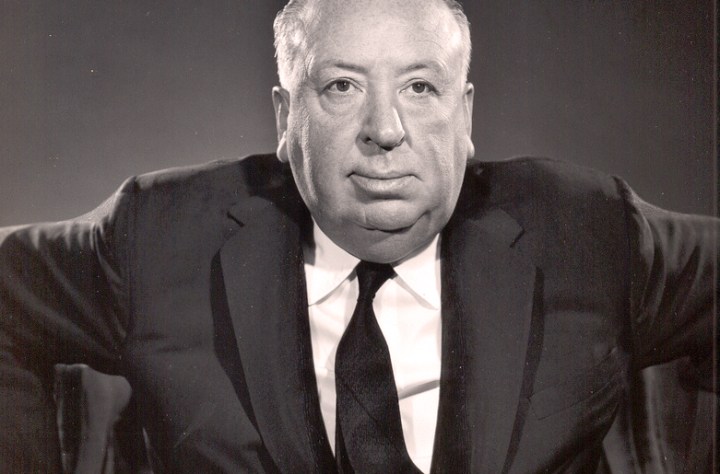Media, Multimedia
Alfred Hitchcock, still the master of mystery, after all these years

Exactly 30 years ago, one of the world's best directors of all time, Alfred Hitchcock, died in Los Angeles. Or so we’ve been told. For all we know, he might be somewhere between worlds, plotting his next mystery wrapped in an enigma inside a riddle.
For years, from the mid-1960s onward, the spooky melody of Charles Gunoud’s “Funeral March of a Marionette” drew television viewers into their lounges to watch “Alfred Hitchcock Presents”. In South Africa we’ve only seen episodes as re-runs or hired them, but they’ve still galvanised us. In the famous opening sequence, the camera fades to a simple line-drawing caricature of Hitchcock’s rotund profile and, as the music plays, the master, himself, appears in silhouette from the edge of the screen, walks to centre screen, replaces the caricature and says, in his unforgettably ghoulish voice, “Go-o-o-d e-ev-e-ning….”
Watch: North by Northwest trailer (1959)
But for more than 30 years before that idiosyncratic sequence, Alfred Hitchcock had already become the master of the psychological thriller, and he was almost certainly the most important filmmaker to come out of the UK. Born on 13 August 1899 in Leytonstone, London, Hitchcock was the son of a greengrocer and poultry dealer, and a mother who seems to have been an expert in home-based psychological torment, with methods that worked their way deep into Hitchcock’s films. Hitchcock once said he drew upon the psychological torments of his childhood to create the twisted textures of his most infamous character, the warped Norman Bates in “Psycho”.
He directed more than 50 feature films. Britain’s The Daily Telegraph said he was “unquestionably the greatest filmmaker to emerge from these islands, Hitchcock did more than any director to shape modern cinema, which would be utterly different without him. His flair was for narrative, cruelly withholding crucial information (from his characters and from us) and engaging the emotions of the audience like no one else.”
In his early cinematic efforts, Hitchcock worked for the London branch of what became Paramount Pictures, before moving on to other studios in the UK and then working in Germany. Not surprisingly, considering his life’s output, Hitchcock once told Francois Truffaut that he had been strongly influenced by Fritz Lang’s film, “Destiny”. In his own early work, the first really Hitchcockian film was “The Lodger: A Story of the London Fog”, with its telltale switcheroo of the man wrongly accused.
Watch: LIfeboat fishing scene (1944)
By 1929, Hitchcock had begun to evolve his special vocabulary, working in early talkie films he had already begun putting special emphasis on important words like “knife” in a thriller, using famous buildings as backdrops and using the “MacGuffin” technique – an item of key importance in the film that moves the plot along until the real story is finally revealed. After a string of British successes he moved to the US in 1939 and began working for the legendary David O Selznick on such great films as his gothic tale “Rebecca”. About this time, too, Hitchcock spoke one of his most famous non-film lines: “Actors should be treated like cattle”.
Watch: Vertigo trailer (1958)
Among a host of great works, Hitchcock made several great war films – “Saboteur”, “Foreign Correspondent” and “The Life Boat.” In the latter, with its claustrophobic story of a small group of people huddled in a life boat after their freighter is torpedoed, he had to be imaginative to apply his characteristic device of appearing as a quick cameo in each film – something his fans had come to wait for every time and which has been emulated by modern directors such as M Night Shyalaman and Quentin Tarantino.
Watch: The Shower scene from Psycho (1960)
Hit after hit continued in Hitchcock’s career as he worked with favourite thespians such as Cary Grant, James Stewart, Ingrid Bergman and Grace Kelly in classics like “Rear Window”, “Dial M for Murder”, “To Catch a Thief”, “Vertigo” and that wonderful remake of his own earlier film, “The Man Who Knew Too Much”. Then came the trio of what many think are his very best: “North by Northwest”, “Psycho” and “The Birds”. The last film of an extraordinary career was “Family Plot”, which Hitchcock finished in 1976.
Watch: The Birds trailer (1963)
Among his many technical innovations, was the trademark Dolly zoom – used to great effect in “Vertigo” – where the camera moves in the opposite direction from the zoom-in effect itself to stretch the image.
Hitchcock once commented about his work: “The writer and I plan out the entire script down to the smallest detail, and when we’re finished, all that’s left to do is to shoot the film. Actually, it’s only when one enters the studio that one enters the area of compromise. Really, the novelist has the best casting since he doesn’t have to cope with the actors and all the rest.” Sounds just about right for him, doesn’t it?
By J Brooks Spector
For more, read about Hitch at Wikipedia and at the Internet Movie Database, among many other sources about his work – or the man.















 Become an Insider
Become an Insider